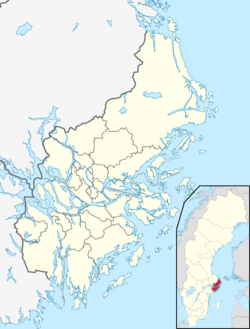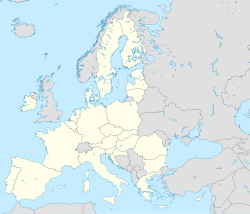Sigtuna
Sigtuna | |
|---|---|
 Stora gatan, the old main street | |
 Coat of arms | |
 Sigtuna | |
| Coordinates: 59°37′N 17°43′E / 59.617°N 17.717°ECoordinates: 59°37′N 17°43′E / 59.617°N 17.717°E | |
| Country | Sweden |
| Province | Uppland |
| County | Stockholm County |
| Municipality | Sigtuna Municipality |
| Area | |
| • Total | 4.57 km2 (1.76 sq mi) |
| Population (31 December 2010)[1] | |
| • Total | 8,444 |
| • Density | 1,849/km2 (4,790/sq mi) |
| Time zone | UTC+1 (CET) |
| • Summer (DST) | UTC+2 (CEST) |
| Website | Official website |



Sigtuna (Swedish pronunciation: [ˈsɪ̂kːˌtʉːna])[2] is a locality situated in Sigtuna Municipality, Stockholm County, Sweden with 8,444 inhabitants in 2010.[1] It is the namesake of the municipality even though the seat is in Märsta. Sigtuna is for historical reasons often still referred to as a stad.
Modern-day Sigtuna, a harbor town that was established around 980, developed approximately 4 kilometres east of Old Sigtuna (which according to Norse mythology, was previously the home of Odin).[3]
Sigtuna has a medieval-style town centre with restaurants, cafes and small shops. The old church ruins, runic stones and the old main street (Stora gatan) are popular attractions for tourists especially in the summertime. The small streets with the low built wooden houses lead up to several handicrafts shops and the old tiny town hall, (Sigtuna Rådhus). There are restaurants and Sigtuna Stadshotell, a hotel in the town centre.[4]
Geography[]
Sigtuna is situated at the bay Skarven, stretching around Upplands-Bro and a part of Lake Mälaren.
Etymology[]
The name of Sigtuna was moved from what is presently called Signhildsberg. The meaning of Sigtuna is contested. According to one theory, it is a compound name where the second element is -tuna and the first one is either of two closely related dialectal words, viz. sig meaning "seeping water" or "swamp" or sik meaning "swamp". As a basis for this intpretation, a brook south of Signhildsberg has been mentioned, or the fact that the estate was surrounded by marshy terrain.[5]
Another theory considers the name to be an ancient prestigious "wander toponym", meaning "strong fortress", like the Celtic toponym Segodunum, [5] from Proto-Germanic *sigatūna, Old Norse Sigtún, cf. Proto-Germanic *segaz ~ *sigiz- "victory": Gothic WIKI


